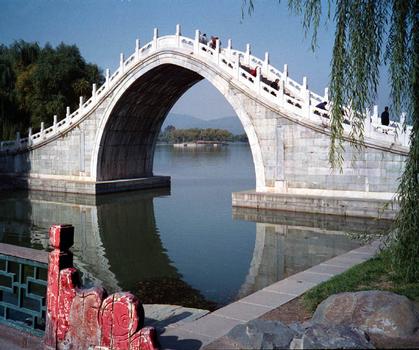General Information
Project Type
| Structure: |
Moon bridge |
|---|---|
| Function / usage: |
Pedestrian bridge (footbridge) |
| Structure: |
Pointed arch bridge |
| Material: |
Masonry bridge |
Location
Technical Information
Materials
| arch |
stone
|
|---|
Excerpt from Wikipedia
The Jade Belt Bridge (simplified Chinese: 玉带桥; traditional Chinese: 玉帶橋; pinyin: Yù Dài Qiáo), also known as the Camel's Back Bridge, is an 18th-century pedestrian moon bridge located on the grounds of the Summer Palace in Beijing, China. It is famous for its distinctive tall thin single arch.
The Jade Belt Bridge is the most well-known of the six bridges on the western shore of Kunming Lake. It was erected in the years 1751 to 1764, during the reign of the Qianlong Emperor, and was built in the style of the delicate bridges in the country-side of southern China. It is made from marble and other white stone. The ornate bridge railings are decorated with carvings of cranes and other animals. The clearance of the arch was chosen to accommodate the dragon boat of the Qianlong Emperor. As the Kunming Lake inlet to the neighboring Yu River, and when during special occasions, the emperors and empress and their dragon boat would specifically pass under this bridge. It is one of the most beautiful bridges in the Summer Palace.
Text imported from Wikipedia article "Jade Belt Bridge" and modified on July 22, 2019 according to the CC-BY-SA 4.0 International license.
Participants
Currently there is no information available about persons or companies having participated in this project.
Relevant Web Sites
Relevant Publications
- (2002): Bridges that Changed the World. Prestel, Munich (Germany), pp. 60-61.
- (2003): Bridging the World. Bridge Ink, Wilsonville (USA).
- (2002): Brücken, die die Welt verbinden. Prestel, Munich (Germany), pp. 60-61.
- (1999): Kanäle, Brücken und Zisternen. Berichte aus den antiken Kulturen Ägyptens, Mesopotamiens, Südwestarabiens, Persiens und Chinas. In: Bautechnik, v. 76 ( 1999), pp. 1-88.
- (1999): Tierra sobre el agua. Visión histórica universal de los puentes. Colegio de Ingenieros de Caminos, Canales y Puertos, Madrid (Spain), pp. 122-123.
- About this
data sheet - Structure-ID
20002220 - Published on:
09/11/2001 - Last updated on:
28/05/2021







